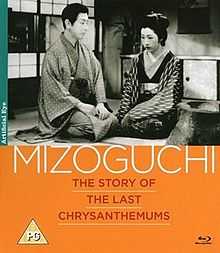The Story of the Last Chrysanthemums
| The Story of the Last Chrysanthemums | |
|---|---|
 DVD cover | |
| Directed by | Kenji Mizoguchi |
| Written by |
Shôfû Muramatsu (novel) Matsutarō Kawaguchi Yoshikata Yoda |
| Starring |
Shôtarô Hanayagi Kôkichi Takada Gonjurô Kawarazaki |
| Music by |
Shirô Fukai Senji Itô |
| Cinematography |
Yozô Fuji Minoru Miki |
| Edited by | Koshi Kawahigashi |
| Distributed by | Shochiku |
Release dates |
|
Running time | 142 minutes |
| Language | Japanese |
The Story of the Last Chrysanthemums (残菊物語 Zangiku monogatari)) is a 1939 Japanese film directed by Kenji Mizoguchi.
The film is regarded as one of Mizoguchi's greatest pre-war achievements. Especially notable is Mizoguchi's now mature mise-en-scène compositions and extreme long takes.
Plot
The film is set in Japan in 1885. Kikunosuke Onoe, played in his movie debut by the stage actor Shotaro Hanayagi, is the adoptive son of a famous Kabuki actor, who is training to succeed his father in an illustrious career. While hypocritically praising Onoe's acting to his face, the rest of his father's troupe deride him behind his back. Otoku (Kakuko Mori), the young wet-nurse of Onoe's adoptive father's infant son, is the only one frank enough to disclose his artistic shortcomings and urge him to improve himself. When Otoku is dismissed by Onoe's family for her closeness to the young master, with its potential for scandal, Onoe is outraged and leaves Tokyo to hone his art away from his father, much to the latter's wrath.
Otoku eventually joins Onoe as his common law wife and encourages him, through many difficult times, to persevere with his career. When Onoe finally has his chance to join a famed Tokyo troupe, and establish himself as a nationally renowned Kabuki actor, Otoku (unknown to Onoe) sacrifices their relationship to enable Onoe to seize this opportunity and reconcile with his father. Though ultimately Onoe's father accepts Otoku as Onoe's wife, this reconciliation comes only when she is already on her deathbed with tuberculosis – like the wilting chrysanthemums of late fall, she dies at the moment of her husband's theatrical triumph.
Cast
- Shôtarô Hanayagi as Kikunosuke Onoue
- Kôkichi Takada as Fukusuke Nakamura
- Gonjurô Kawarazaki as Kikugoro Onoue
- Kakuko Mori as Otoku
- Tokusaburo Arashi as Shikan Nakamura
- Yôko Umemura as Osata
Production
The film's production happened at a time a transition for Mizoguchi. In 1939 he was appointed a National Film consultant in Japan and sent to Manchuria with five other film directors. He also left Toho for Shochiku Studios after several years of success at Toho. The Story of the Last Chrysanthemums he his first film in a trilogy about theater in the Meiji period.[1] It was very successful in Japan and won 2nd place of Kinema Jumpo's list of best films. Mizoguchi also won an Education Ministry Award for the film.[2]
Style
Mizoguchi used many long takes in the film, often lasting up to six minutes. He also used many dolly shots for dramatic effects and in order to enhance the emotional state of the characters. He utilized both the foreground and the background in many shots.[3] Derek Malcolm said that "If Mizoguchi was the poet of women, he was also the poet of houses, rooms, landscape and urban vistas. His period detail and sumptuous camera style lent his stories a fantastic naturalism, heightened by an almost musical editing style."[4]
Legacy
Jonathan Rosenbaum called it Mizoguchi's greates film and praised his "refusal to use close-ups…the theme of female sacrifice that informs most of his major works is given a singular resonance and complexity here."[5] Derek Adams of Time Out called it "a heartbreaker to end them all" and praised its cinematography.[6] Richard Brody called it "one of the cinema’s great outpourings of imaginative energy."[3] Noel Burch called it "one of his most deeply ‘feminist’ films"[7] and Tony Rayns called it "the peak of Mizoguchi's art."
John Pym praised the film's sets, saying that they were "crammed with human detail" and that when they were "sometimes offset by shots of notably uncluttered spaces, [it] is to highlight the isolation of the two principles in a teeming world dominated by class prejudice, harsh economics, and sheer blank human indifference."[2]
The film was selected to be screened in the Cannes Classics section of the 2015 Cannes Film Festival.[8]
See also
- Zangiku monogatari (1956 film)
- Zangiku monogatari (1963 film)
References
- ↑ Wakeman, John. World Film Directors, Volume 1. The H. W. Wilson Company. 1987, p. 792.
- ↑ 2.0 2.1 Wakeman. p. 793.
- ↑ 3.0 3.1 Brody, Richard (May 12, 2014). "Ladies' Man". The New Yorker. Retrieved February 22, 2015.
- ↑ Malcolm, Derek (December 2, 1999). "Kenji Mizoguchi: The Story of the Late Chrysanthemums". The Guardian. Retrieved February 22, 2015.
- ↑ Rosenbaum, Jonathan. "The Story of the Last Chrysanthemums". Chicago Reader (Chicago, IL). Retrieved February 22, 2015.
- ↑ Adams, Derek. "The Story of the Late Chrysanthemums". Time Out. Retrieved February 22, 2015.
- ↑ Wakeman. p. 792.
- ↑ "Cannes Classics 2015". Cannes Film Festival. 29 April 2015. Retrieved 30 April 2015.
External links
- The Story of the Last Chrysanthemums at the Internet Movie Database
- The Story of the Last Chrysanthemums at Rotten Tomatoes
- The Story of the Last Chrysanthemums at AllMovie
| ||||||